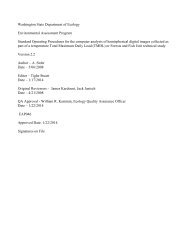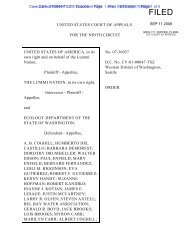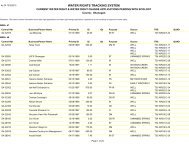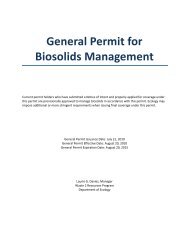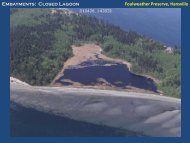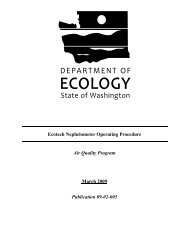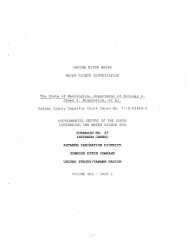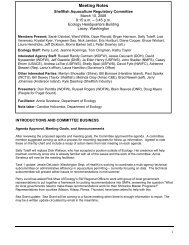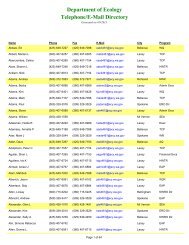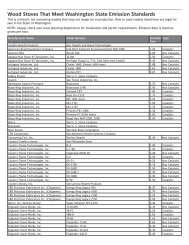WRIA 62 WMP 032305 - Washington State Department of Ecology
WRIA 62 WMP 032305 - Washington State Department of Ecology
WRIA 62 WMP 032305 - Washington State Department of Ecology
You also want an ePaper? Increase the reach of your titles
YUMPU automatically turns print PDFs into web optimized ePapers that Google loves.
March, 2005 -59- 023-1289-003.3040<br />
and swimming), is an aesthetic concern and may be negatively impacting resident fish populations<br />
(Pend Oreille County, 2003). The Pend Oreille River is listed for pH on <strong>Ecology</strong>’s 303d list <strong>of</strong><br />
impaired waters. High pH levels are likely caused by aquatic weed growth. The intent <strong>of</strong> this issue is<br />
to help address this water quality impairment by implementing public education activities and<br />
bringing together a group <strong>of</strong> stakeholders within Phase IV <strong>of</strong> Watershed Planning to agree upon<br />
actions to reduce the distribution and densitie s <strong>of</strong> Eurasian watermilfoil and, to a lesser degree, other<br />
aquatic nuisance weeds such as curly pondweed in <strong>WRIA</strong> <strong>62</strong>.<br />
In 1991 the Legislature appropriated funding (paid for through boat and trailer licensing fees) for the<br />
establishment and maintenance <strong>of</strong> an Aquatic Plants Management program through <strong>Ecology</strong> to<br />
prevent the establishment and control <strong>of</strong> aquatic weeds. The program includes educational, technical<br />
and financial assistance. Grants (application cycle 1 Oct-1 Nov) are available for planning, research,<br />
implementation, and education/outreach. The web site link<br />
(http://www.ecy.wa.gov/programs/wq/links/plants.html) describes in detail what services are<br />
available and grant application criteria. <strong>Ecology</strong> is planning an "Aquatic Plant School" in cooperation<br />
with Portland <strong>State</strong> University and the Smithsonian for 2005. <strong>Ecology</strong> contacts for this event and for<br />
additional information on <strong>Washington</strong> <strong>State</strong> funded measures to combat the introduction and spread<br />
<strong>of</strong> milfoil are:<br />
<strong>WRIA</strong> <strong>62</strong> <strong>WMP</strong> <strong>032305</strong><br />
• Kathy Hamel, <strong>Ecology</strong>/Water Quality, Tel: (360) 407-65<strong>62</strong>, Email:<br />
kham461@ecy.wa.gov; and,<br />
• Jenifer K Parsons, <strong>Ecology</strong>/Environmental Assessment Program, Tel: (509) 457-7136;<br />
Email: jenp461@ecy.wa.gov.<br />
4.2.3 WQUAL-3a Background and Rationale<br />
Problem <strong>State</strong>ment: There is a need to participate in current and future Total Maximum Daily<br />
Load (TMDL) processes and provide input on TMDLs for tributary streams that originate<br />
within <strong>WRIA</strong> <strong>62</strong>.<br />
The Clean Water Act requires <strong>State</strong>s and Tribes with water quality jurisdiction to develop a list <strong>of</strong><br />
waterbodies not meeting water quality standards. Development <strong>of</strong> Total Maximum Daily Loads<br />
(TMDLs) is the process by which <strong>State</strong>s and Tribes attempt to achieve water quality standards.<br />
<strong>Washington</strong> <strong>State</strong> has jurisdiction over waterbodies within <strong>WRIA</strong> <strong>62</strong>, with the exception <strong>of</strong> waters<br />
within the exterior boundaries <strong>of</strong> the Kalispel Indian Reservation. The Kalispel Tribe has jurisdiction<br />
over waterbodies on Kalispel Indian Reservation lands. Idaho <strong>State</strong> has jurisdiction over waterbodies<br />
within Idaho. The role <strong>of</strong> the Environmental Protection Agency (EPA) is to review and approve<br />
TMDLs and ensure that the TMDLs will work towards attaining applicable water quality standards<br />
(i.e. <strong>State</strong> and Tribal water quality standards).<br />
Information on the <strong>WRIA</strong> <strong>62</strong> 303(d) listings and current TMDL activities are included in the Phase II,<br />
Level 2 report (Golder, 2005). At present there are no on-going TMDLs for tributary streams to the<br />
Pend Oreille River in <strong>WRIA</strong> <strong>62</strong> outside <strong>of</strong> the Colville National Forest. There are completed and<br />
ongoing TMDLs on tributary streams to the Priest River Basin in Idaho that originate in <strong>WRIA</strong> <strong>62</strong>.<br />
Completed and on-going TMDLs are illustrated on Figure 4-6. TMDLs in Idaho are listed in Table 4-<br />
6.



